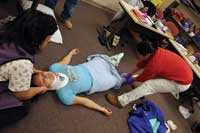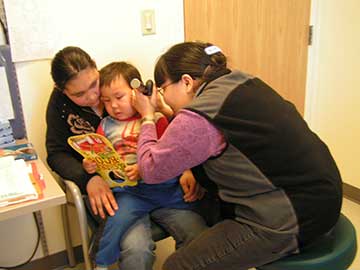Guide to YKHC Medical Practices:Community Health Aide Program (CHAP)
The Community Health Aide Program was developed to meet the healthcare needs of rural Alaska in the 1950s and 1960s. When the TB epidemic was sweeping through Alaska in the 1950s, the possibility of home treatment provided the opportunity to utilize village workers in the Bethel region to distribute antibiotics. This successful demonstration of the use of local people as health care providers led to the concept of the Community Health Aide Program (CHAP), which was established with funding from IHS in 1968.
The Community Health Aide Program is a sustainable, successful, and culturally acceptable health care delivery system in Alaska Native villages. With focused training and support, community health professionals deliver quality care in rural environments.
Community Health Aides/Practitioners are local people who are trained to become often the only healthcare provider in their community. Not only are they seeing patients during normal clinic hours but must also provide on-call service after hours. They receive training at one of a few training centers in Alaska to work within the guidelines of the Alaska Community Health Aide/Practitioner Manual (CHAM).
The CHAM outlines assessment and treatment protocols and they work closely with providers in Bethel or Subregional Clinics (SRC) to provide these services. Communication with providers happens with what we still call Radio Medical Traffic (or RMT) from back when VHF radios were the only way to communicate from the village to Bethel (or often from village to village to Bethel).
Being a Community Health Aide/Practitioner is a demanding position with the health care of the community being their responsibility twenty-four hours a day. It’s important that they are supported by everyone including their family, their community members, village leadership, and corporate leadership.
Health Aide Training
Scope of Care Provided
Training is provided to approximately 160-190 Health Aide/Practitioners from 47 communities serviced by YKHC. Levels of Training include Pre-session, Session I, Session II, Session III, Session IV and Preceptorship.
Mechanism Used to Identify Patient Care Needs
Training sessions are scheduled based on the number of CHA/Ps who need to progress to the next level. It is the goal of the training program is for all CHA/Ps to become certified as a Community Health Practitioner, the highest level of training and practice for a CHA/P.
How the Department is Staffed to Meet the Patient Care Needs
There are eight budgeted positions for Basic Training Instructors (BTIs). BTIs are either Nurse Practitioners or Physicians Assistants.
Process on Acting on Negative and Positive Variances
Negative variances such as permanent staff shortage require the training schedule to be modified to meet the staffing restraints.
Clinic Supervision
Scope of Care Provided
Approximately 160-190 CHA/Ps in 47 villages provide primary preventative, acute, and first responder care.
Mechanism Used to Identify Patient Care Needs
Patient need is identified by either direct referral from patient or family, referral from schools or other community sources, or referral from medical providers at secondary or tertiary sources in Bethel at the Yukon-Kuskokwim Delta Regional Hospital or in Anchorage at Alaska Native Medical Center.
How the Department is Staffed to Meet the Patient Care Needs
Staffing needs were determined by analysis of the annual actual numbers of patient encounters in the clinic. Staffing patterns were applied according to these numbers, and this number of positions per clinic has remained static.
Compliance
Scope of Care Provided
Program performance is measured and evaluated with regard to internal and external hospital regulations set forth by The Joint Commission and YKHC policies and procedures. Frequent village travel and close working relationships with Field Supervision staff ensure CHA/Ps are trained on proper clinic compliance.
Mechanism Used to Identify Patient Care Needs
Need is determined by compliance trends in village clinics, with patient safety being the top priority. Feedback by community members through Customer Comment Cards, Patient Encounter Reviews by the Clinic Quality Instructor, and board directives often give direction to the compliance program.
How the Department is Staffed to Meet the Patient Care Needs
The Community Health Aide Compliance Program is staffed with 1.0 FTE Bachelors- level Compliance Officer who has graduated from an accredited Environmental Health or similar program or who has obtained certification as a Registered Nurse.
Process on Acting on Negative and Positive Variances
With the assistance of Field Supervision staff, routine visits to clinics includes compliance through a site survey tool. Supervisor Instructors visit each of their assigned clinics an average of one visit per quarter. This allows for follow-up to compliance issues identified in previous trips. The Compliance Officer works closely with the Director of CHAP/Education and the Field Supervision Coordinator to identify and address different clinic compliance issues. Monthly and quarterly reporting provide feedback on the effectiveness of the program.

